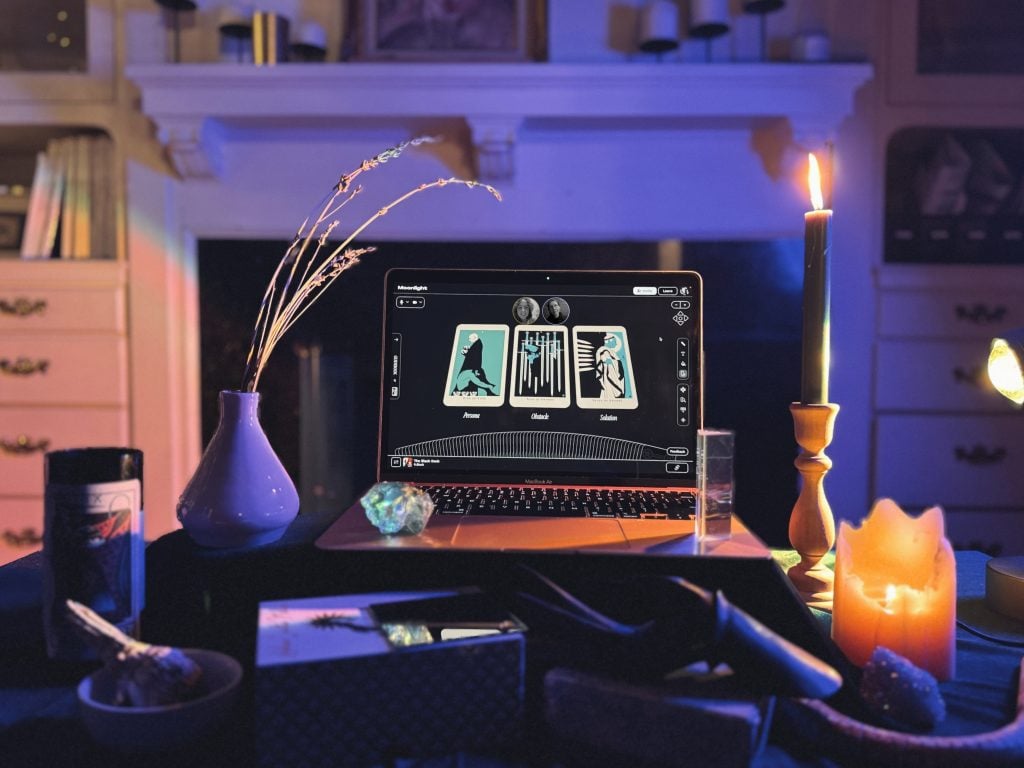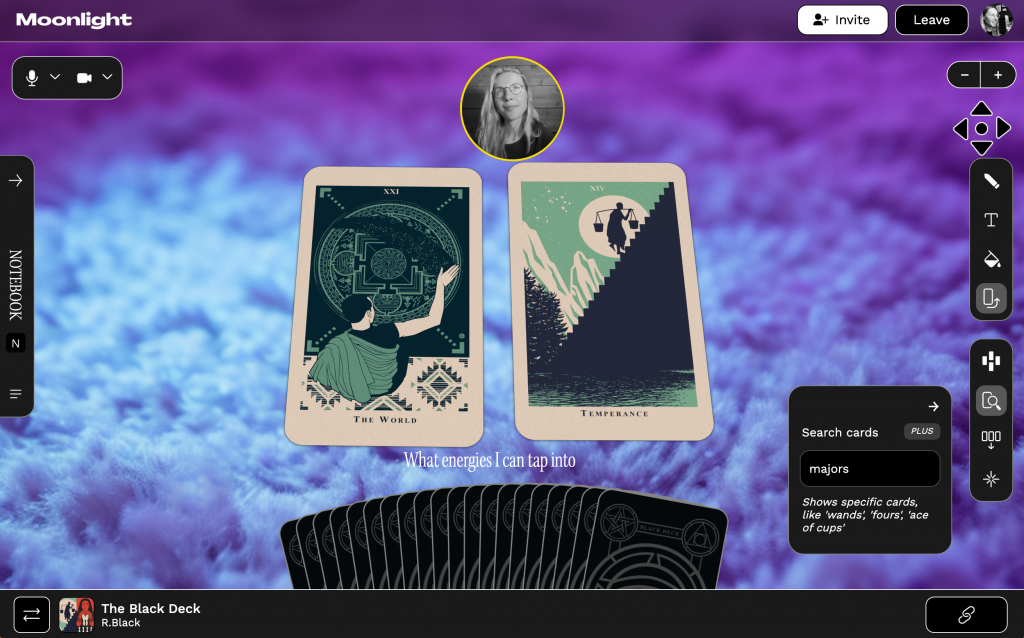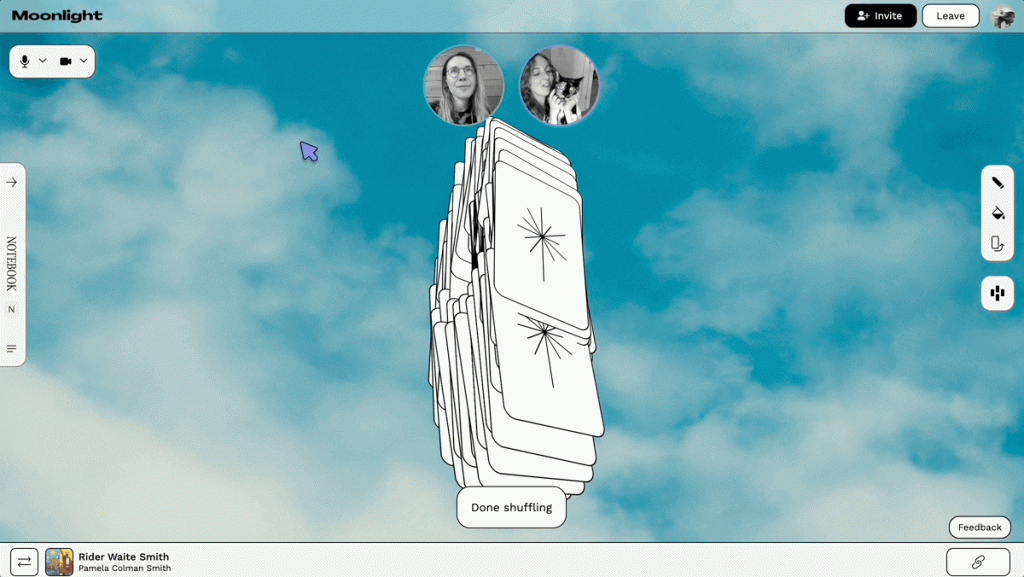Art World
A Virtual Tarot Platform With Artist-Designed Decks Is Now Offering Readings
The latest project by internet performance artist Danielle Baskin makes tarot easily accessible.

Performance artist and satirist Danielle Baskin has produced numerous viral projects over the past decade, proposing blue checkmarks for the homes of influencers and emblazoning pineapples with brand logos. Some have grown into actual businesses. In 2022, though, Baskin sold off all her enterprises to build Moonlight, a virtual tarot platform that now offers professional readings and lessons. Moonlight marks the first time Baskin has focused on one project. And, unlike previous endeavors, it’s entirely earnest.
The platform offers tarot rooms where professionals and amateurs alike can pull from the iconic Rider Waite Smith and Marseilles decks either on their own, or in one-on-one readings over video chat. The hardest part of tarot is asking the right question. The second-hardest part is designing a spread so the cards can answer. Fortunately, Moonlight has four pre-stocked spreads, including the ubiquitous Celtic Cross. Or, users can opt for a blank spread and pull cards as they see fit. There’s a drawing feature available for free, but typing permanently on the table requires a paid account. Users can also purchase and use digital decks by established tarot artists, like mycologist Chris Adams.

The user interface of Moonlight. Courtesy of Moonlight.
Last month, Moonlight rolled out its directory. Now, users seeking readings or lessons can book tarot sessions from 20 hand-selected readers, each pairing tarot with modalities from hermetic spirituality to African religions. Furthermore, Moonlight oversees secure payments, doing their part to dispel the scammers trailing tarot’s rise.
Moonlight emerged from DialUp, a voice-based social network Baskin co-launched in 2018. Her love for tarot, though, took shape 15 years ago. “I started a business painting helmets,” Baskin told me. “I had this idea to paint a whole deck of tarot cards and distribute them in the same city.” Baskin learned tarot by painting those 78 helmets—then by peddling them at tarot conferences. Two years after moving to San Francisco and relinquishing that business, she and Max Hawkins debuted DialUp, which connects users for random calls according to interests like cooking, travel, and tarot. While giving readings over DialUp, Baskin began longing for a more intimate, visual platform.
1,200 people joined DialUp’s weekly tarot nights in 2019. Attendance surged in 2020. Baskin attributes tarot’s rapid expansion to uncertain times—alongside the rise of TikTok and Instagram Live. Unchecked growth, however, has left gaps. Scammers incessantly impersonate famed tarot readers and solicit payments over social media from unwitting fans. Baskin put herself in a rookie’s shoes and tried using Google to find a real reader. She got served a sea of sketchy psychic hotlines instead. What’s more, she noted, “a lot of mass tarot is sensationalized.” While social media algorithms reward collective readings with eye-catching headlines, Moonlight encourages initiates to build their own contemplative relationship with the cards.

The user interface of Moonlight. Courtesy of Moonlight.
First, she perfected Moonlight’s shuffling mechanics. Legions of beta testers sampled several visualizations. “They weren’t even tarot cards,” Baskin said. All that mattered was recreating the sensation of fluttering paper. Moonlight’s decks undulate hypnotically until someone presses “Done.” Then they splay out below. It’s not a meaningless animation—each card carries its own JPEG all the while. “When you’re hovering over that card, it’s not doing a random number generator,” Baskin clarified. She sought further feedback on prototypical tarot tables from hobbyists and professionals, even consulting her cards to create Moonlight’s website. The landing page evokes the Rider Waite Smith deck’s Ace of Cups, signifying a new start.
Moonlight also translates five artist-designed decks from print onto their platform. Some, like the holographic cyberpunk Eldritch Overload deck by Brenda Ho and Thom Denick, come with custom backgrounds. Each deck’s imagery presents a distinct take on tarot’s timeless archetypes. Perhaps that’s why artists from Manzel Bowman to Hilma’s Ghost have produced their own decks, Baskin posited. Painting the full tarot is a practice in portraying all life’s episode.
Thus, Baskin finds herself on the frontlines of yet another zeitgeist. It’s not just that she’s clairvoyant—she knows how to listen. She’s used tarot to formulate her projects all along, and understands that the cards, while seen as taboo, have a sense of humor, too. “There’s a lot of weird tarot stuff out there I feel like is the opposite of what tarot is,” Baskin said. “Moonlight felt very important to me, as though tarot itself asked me to build its technology.”





